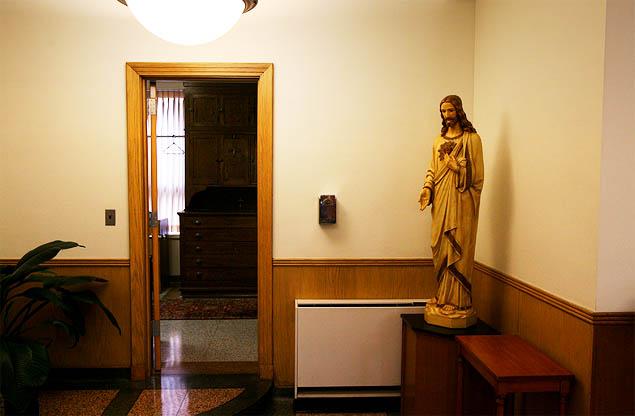Justice Story: Killer Priest Murders Nun in Chapel Sacristy, Leaves Demonic Stab Pattern over Her Heart
By David J. Krajicek
The nun's killer left behind a pointed message. Sister Margaret Ann Pahl, 71, was murdered on the morning before Easter in 1980, an ungodly act on Holy Saturday. Her body was found in the chapel sacristy at Mercy Hospital in Toledo, Ohio. She had been confronted by her killer as she prepared for that day’s services. Pahl was choked to death’s door, jabbed mercilessly with a letter opener, and then sexually violated. She was found with an altar cloth shrouding her torso. It was a ritual murder with hallmarks of pathological rage. Among 31 stab wounds, nine punctures over her heart formed the outline of an inverted Crucifix, a demonic symbol. She had been stripped below the waist and defiled with a cross. The homicide was unthinkable. Who would do such a thing to an elderly nun?
On April 8, 1980, mourners attended Pahl’s funeral Mass in Fremont, Ohio. During his homily, the Rev. Jerome Swiatecki, assistant chaplain at Mercy Hospital, called the murder “not only blasphemous but patently absurd.” Seated nearby, the priest’s co-celebrant — the Rev. Gerald Robinson, Mercy’s head chaplain — nodded in agreement. Pahl had dedicated her life to her Catholic faith. Born to an Ohio farm family, she was 19 when she joined the Sisters of Mercy, an order recognized for its nursing. She became a registered nurse and spent 50 years working in Catholic hospitals, mostly as an administrator. The petite nun was known for her meticulousness, and she expected the same from subordinates. Those who did not measure up were subjected to her glowering wrath. Some complained that the bristly taskmaster treated colleagues like third-graders. With her hearing failing as she reached her 60s, Pahl was assigned to Mercy Hospital in Toledo, an hour east of her hometown, to ease into retirement. She lived with about 20 other nursing nuns in a convent on the hospital’s top floor.
Pahl was Mercy’s sacristan, the caretaker of its two chapels. Her duties included everything from overseeing cleaning to preparing hosts and vestments for daily masses. She hadn’t mellowed with age. “She was very, very strict,” housekeeper Shirley Lucas told the Toledo Blade. “Things had to be done a certain way.” But her fussiness hardly seemed a rational motivation for murder. Police questioned scores of witnesses and potential suspects, including hundreds of hospital staffers, her fellow Sisters of Mercy, and the Catholic clerics who worked with her. But Toledo police said they could find none of the physical evidence — fingerprints, fabric threads, secondary blood — that often turns up at murder scenes. As months and years passed without an arrest, the shocking crime faded from the front pages and sank ever deeper in the homicide squad files. It might have been buried forever except for a bit of crime kismet. In 2003, at the height of the Catholic child-abuse scandal, a woman reported that she had been subjected to a childhood of ritualized sex assault by Toledo priests. She named Gerald Robinson, Mercy’s chaplain in 1980, as one of her abusers. An investigation of that allegation went nowhere, but prosecutors took a fresh look at the Pahl case — dormant for two decades — when they discovered that Robinson had been the chief suspect in the murder. Although it was not made public in 1980, detectives had found the letter opener used to stab the nun in Robinson’s office. He had been interrogated and given two lie-detector tests.
But he was never charged — insufficient evidence, police said. Robinson, a native of Toledo, grew up in the city’s Polish section, Kuschwantz, and was ordained in 1964. After a decade of parish pastoring, he was assigned as Mercy chaplain in the mid-1970s, which put him squarely in Sister Margaret Ann Pahl’s infamous glower. The nun could not countenance what she saw as his laxity. And the priest could not stand her withering criticism. On April 23, 2004, the case returned to front pages when Robinson was charged with the murder, based upon evidence available 24 years earlier. What changed? In a book about the case, the Blade’s David Yonke wrote that the Catholic Church had Toledo “wrapped around its little finger” in 1980. Officer Dave Davison told Yonke that all five detectives who investigated the homicide were Catholics. “They sat on it as a courtesy to the church,” Davison said. Robinson’s trial in 2006 featured the testimony of Jeffrey Grob, a Catholic priest from Chicago who specialized in exorcism. He said Pahl’s killer was intimate with religious ritual. The mode of murder was meant to denounce her faith, Grob said. Prosecutor Dan Mandross told the jury that Robinson, a timid introvert, grew furious over the nun’s nitpicks — for example, that he left the sacristy messy when he changed before Mass. Their final argument came on Good Friday 1980, when Pahl criticized the priest for cutting short that afternoon’s traditionally long, solemn Mass. She was killed the next morning. “I think this was the final straw,” Mandross said. “He just snapped.” Robinson was convicted and sentenced to 15 years to life in prison. He continues to claim innocence, though he has failed in a series of appeals. Now 74, he becomes eligible to apply for parole in 2016.
|
.
Any original material on these pages is copyright © BishopAccountability.org 2004. Reproduce freely with attribution.




